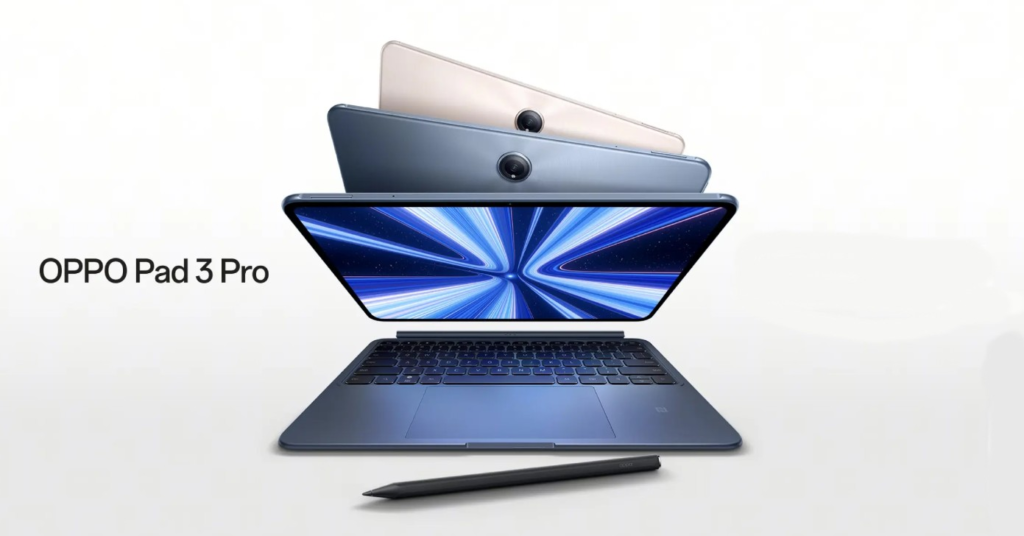Oppo has recently expanded its tablet lineup with the introduction of the Oppo Pad 3 and the Oppo Pad 3 Pro. While the Pad 3 serves as a more budget-friendly option, the Pad 3 Pro offers a higher-end experience. The distinction between these two tablets highlights Oppo’s strategy to cater to a diverse range of consumers. Let’s take a closer look at how these two tablets compare and what sets them apart.
Performance: A Major Divide
One of the most significant differences between the Oppo Pad 3 and the Oppo Pad 3 Pro is their processing power.
The Oppo Pad 3 is powered by the MediaTek Dimensity 8350 chipset. This mid-range SoC is also used in Oppo’s Reno 13 smartphones. Essentially, the Dimensity 8350 is a rebranded version of the Dimensity 8300, with the only major difference being the inclusion of Oppo’s StarSpeed Engine for gaming optimization instead of MediaTek’s HyperEngine. Performance-wise, it is comparable to the Snapdragon 7 Plus Gen 3, making it a reliable option for casual users and moderate multitasking.
In contrast, the Oppo Pad 3 Pro packs the Qualcomm Snapdragon 8 Gen 3 chipset, which is significantly more powerful. This high-end processor is designed for demanding tasks, offering better performance for gaming, video editing, and other resource-intensive applications.
Another distinction lies in storage speed. The Oppo Pad 3 uses UFS 3.1 storage, which is slightly slower than the UFS 4.0 storage found in the Pro model. However, both devices come with LPDDR5x RAM, ensuring efficient memory management.

Display: Subtle but Noticeable Differences
The Oppo Pad 3 and Pad 3 Pro feature large LCD screens, but there are key differences in size, resolution, and brightness:
- Oppo Pad 3:
The Pad 3 is equipped with an 11.61-inch LCD panel. It offers a resolution of 2800 x 2000 pixels, a pixel density of 296 PPI, and a 144Hz refresh rate. With a peak brightness of 700 nits, the display is vibrant and smooth but may struggle slightly under direct sunlight. - Oppo Pad 3 Pro:
The Pro model ups the ante with a slightly larger 11.81-inch display. It boasts a higher resolution of 3000 x 2120 pixels, resulting in a pixel density of 303 PPI. The peak brightness is also improved, reaching up to 900 nits, which enhances visibility in brighter environments.
While both displays deliver a fluid visual experience with their high refresh rates, the Pad 3 Pro edges out with its higher brightness and sharper resolution.

Shared Features: Similarities Across the Lineup
Despite their differences in performance and display quality, the Oppo Pad 3 and Pad 3 Pro share several key features:
- Battery & Charging:
Both tablets are powered by a 9,520mAh battery and support 67W fast charging. This ensures users can enjoy extended usage and recharge quickly when needed. - Ports & Connectivity:
Each device includes a USB 3.2 Gen 1 Type-C port capable of video output and data transfer speeds of up to 5Gbps. Neither tablet offers cellular connectivity, relying instead on Wi-Fi for internet access. - Security & Accessories:
Security is handled via face authentication using the front-facing 8MP camera, as neither device includes a fingerprint sensor. Both models are compatible with Oppo’s official keyboard and stylus accessories, which enhance productivity. - Build & Design:
The tablets share a sleek and durable metal body, giving them a premium feel regardless of the price difference.
Price Comparison: Value vs. Premium Experience
The pricing of the Oppo Pad 3 and Pad 3 Pro highlights their target audiences:
- Oppo Pad 3:
The base model (8GB RAM + 128GB storage) starts at $290. The 8GB + 256GB configuration is available for $330. These price points make it an appealing option for budget-conscious users looking for a capable tablet without breaking the bank. - Oppo Pad 3 Pro:
The Pro model is priced higher, starting at $455 for the 8GB + 256GB variant. For those requiring more memory and storage, the 16GB + 1TB configuration is available for $620. These higher price points reflect the Pro’s superior performance and display quality.
The price gap between the 8GB + 256GB versions of the two models is $125. For this additional cost, the Pro offers a more powerful chipset and a better display. However, if you’re on a budget, the base Pad 3 provides excellent value for its price.

Which One Should You Choose?
The decision between the Oppo Pad 3 and Pad 3 Pro ultimately depends on your priorities and usage needs:
- Choose the Oppo Pad 3 if:
- You are looking for a more affordable tablet.
- Your usage involves casual browsing, video streaming, and light productivity tasks.
- You don’t require the most advanced hardware.
- Opt for the Oppo Pad 3 Pro if:
- You need top-tier performance for gaming, professional work, or multitasking.
- A higher-resolution and brighter display is essential for your usage.
- You’re willing to pay a premium for enhanced features.
Final Thoughts
The Oppo Pad 3 and Pad 3 Pro represent a shift in Oppo’s tablet strategy, offering distinct options for different user needs. While the Pad 3 is perfect for budget-conscious users who want a capable and stylish tablet, the Pro version caters to those seeking a high-performance device with premium features. By understanding their differences, you can select the tablet that best suits your lifestyle and requirements.






